Digging in Zippori
Yesterday, today and tomorrow’s activity involved investigating a first century water system. We are concluding a dig on a cistern in order to determine the flow of water.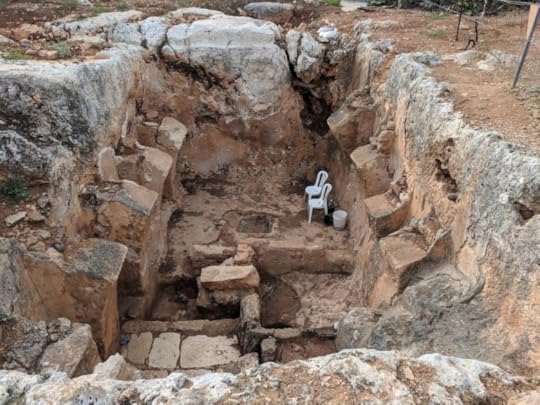 Cistern Archaeology Project at BeginningThe town of Tsippori originated in the fourth century BC (or maybe before) on a high hilltop which offered both protection and a great view. The name Tsippori means “Bird,” perhaps, as the Talmud suggests, because it was "perched on the top of a mountain, like a bird.” (Megillah, 6, 81)
Cistern Archaeology Project at BeginningThe town of Tsippori originated in the fourth century BC (or maybe before) on a high hilltop which offered both protection and a great view. The name Tsippori means “Bird,” perhaps, as the Talmud suggests, because it was "perched on the top of a mountain, like a bird.” (Megillah, 6, 81)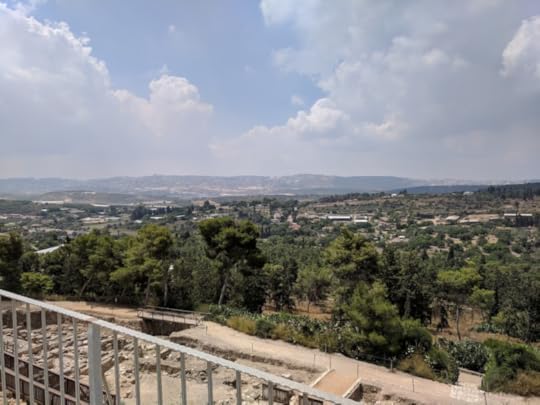 Looking across Galilee, as a BirdThe city was very strong, and for this reason it became a regional capital. According to Josephus, Tsippori was called the "glory of the entire Galilee."
Looking across Galilee, as a BirdThe city was very strong, and for this reason it became a regional capital. According to Josephus, Tsippori was called the "glory of the entire Galilee."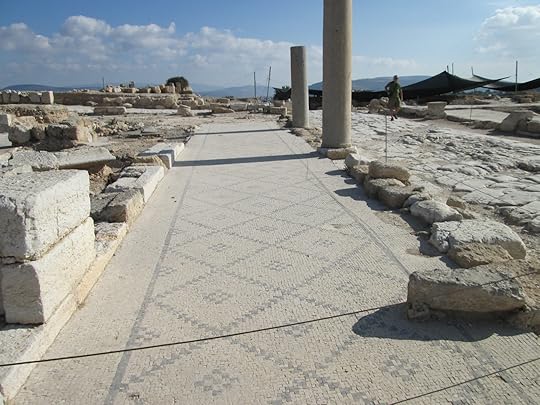 Mosaic walkways in the market in ZipporiWhen Herod's son, Herod Antipas was made tetrarch, he made Sippori the capital of all of Galilee, and began a huge building project.
Mosaic walkways in the market in ZipporiWhen Herod's son, Herod Antipas was made tetrarch, he made Sippori the capital of all of Galilee, and began a huge building project.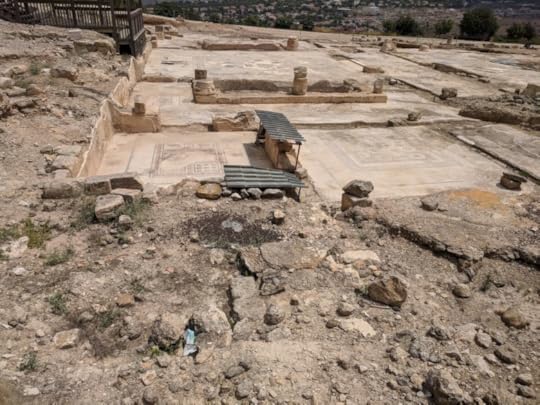 Mosaic floors from homes in SepphorisIt might have been at this time the cistern where we are working was created as a resigour along the aqueduct from water sources around the Nazareth Mountains.
Mosaic floors from homes in SepphorisIt might have been at this time the cistern where we are working was created as a resigour along the aqueduct from water sources around the Nazareth Mountains.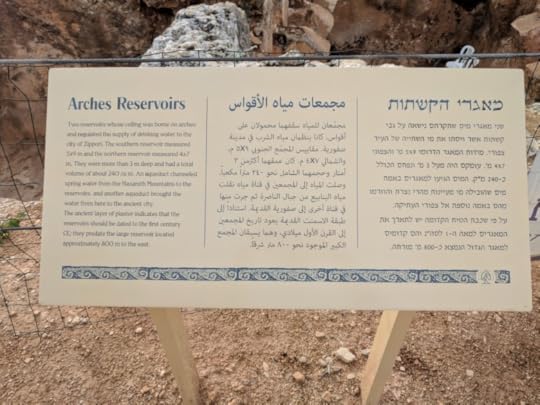 Information sign for the CisternThe population was mixed, but mostly gentiles.
Information sign for the CisternThe population was mixed, but mostly gentiles.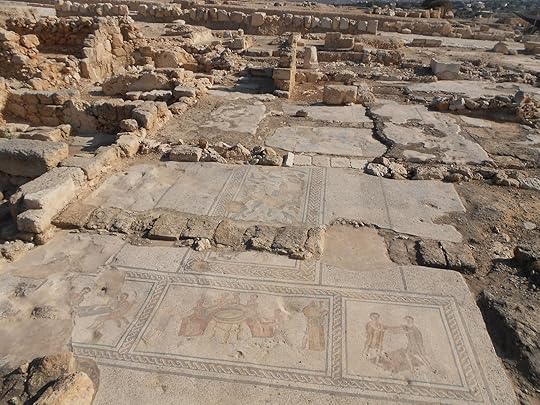 Mosaics from homes in TsipporiThe city is laid out in a typical Roman pattern with wide north-south and east-west cardios. There is a large shopping complex where the main roads cross.
Mosaics from homes in TsipporiThe city is laid out in a typical Roman pattern with wide north-south and east-west cardios. There is a large shopping complex where the main roads cross.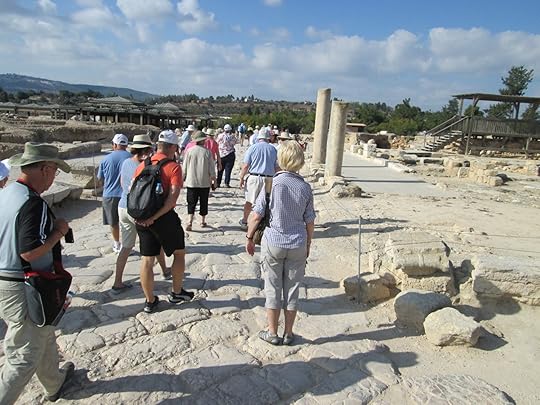 Walking on the old Roman CardioThe homes in Sepphoris were quite ornate and featured mosaic floors.
Walking on the old Roman CardioThe homes in Sepphoris were quite ornate and featured mosaic floors.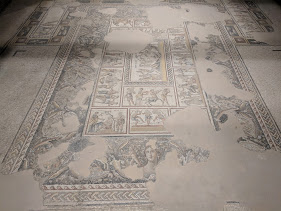 Mosaic Mona Lisa of the GalileeA small Jewish area is located near the top of the hill,
Mosaic Mona Lisa of the GalileeA small Jewish area is located near the top of the hill,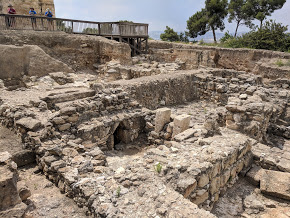 Jewish Neighborhood in ZipporiIt features mikvah pools, which tell of its Jewish character.
Jewish Neighborhood in ZipporiIt features mikvah pools, which tell of its Jewish character.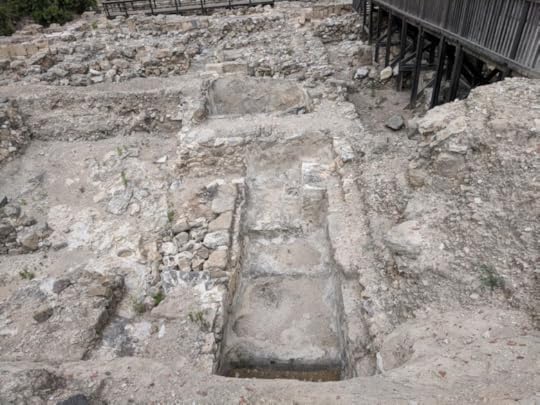 Looking at a Mikvah PoolThe Sanhedrin met here for a time after the destruction of the Temple.
Looking at a Mikvah PoolThe Sanhedrin met here for a time after the destruction of the Temple.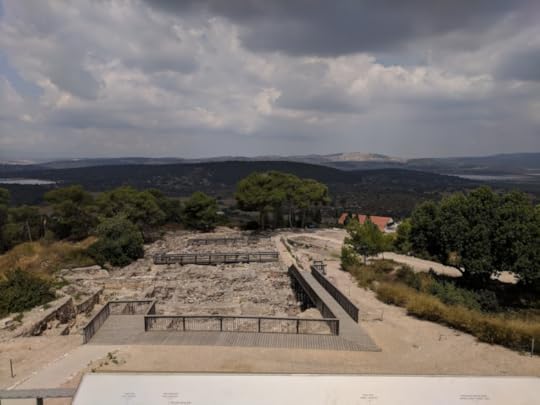 Bird's Eye View of Jewish Neighborhood, Mount Carmel in backgroundRabbi Yehuda Hanassi transferred the seat of the Sanhedrin from Bet She'arim to Tsippori, and around 220 CE he completed the Mishna in the city.
Bird's Eye View of Jewish Neighborhood, Mount Carmel in backgroundRabbi Yehuda Hanassi transferred the seat of the Sanhedrin from Bet She'arim to Tsippori, and around 220 CE he completed the Mishna in the city. 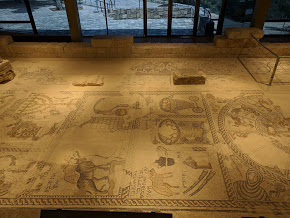 Synagogue MosaicThe Synagogue of the city saw several renovations over the years. The mosaic floor of the fifth century Synagogue is enclosed with a multimedia presentation. It contains scenes from Bible stories, priestly offerings and a zodiac diagram.
Synagogue MosaicThe Synagogue of the city saw several renovations over the years. The mosaic floor of the fifth century Synagogue is enclosed with a multimedia presentation. It contains scenes from Bible stories, priestly offerings and a zodiac diagram.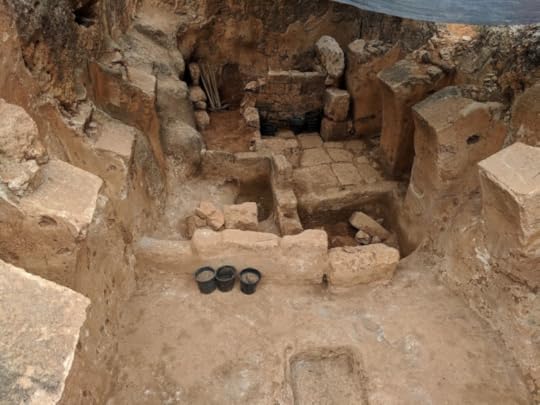 Cistern Project this evening, compare for progressOur work on the water cistern has made huge strides in the past few days.
Cistern Project this evening, compare for progressOur work on the water cistern has made huge strides in the past few days.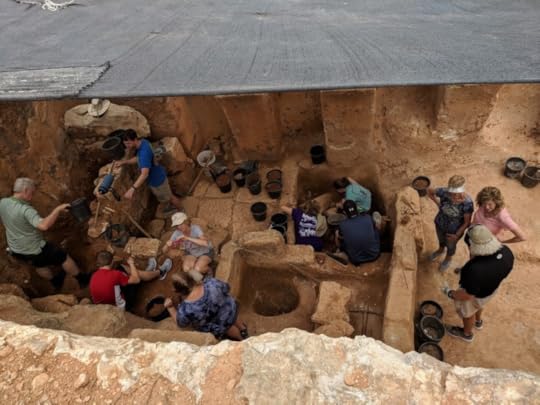 Tour Group from Georgia that helped us digWe have found pottery, old nails, roof tiles, some Roman glass, and old coins.
Tour Group from Georgia that helped us digWe have found pottery, old nails, roof tiles, some Roman glass, and old coins.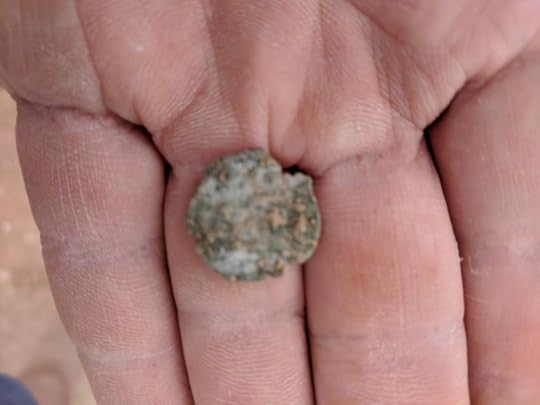 One of the coins found at Tsippori
One of the coins found at Tsippori
The archaeological dig was productive and enjoyable.
 Cistern Archaeology Project at BeginningThe town of Tsippori originated in the fourth century BC (or maybe before) on a high hilltop which offered both protection and a great view. The name Tsippori means “Bird,” perhaps, as the Talmud suggests, because it was "perched on the top of a mountain, like a bird.” (Megillah, 6, 81)
Cistern Archaeology Project at BeginningThe town of Tsippori originated in the fourth century BC (or maybe before) on a high hilltop which offered both protection and a great view. The name Tsippori means “Bird,” perhaps, as the Talmud suggests, because it was "perched on the top of a mountain, like a bird.” (Megillah, 6, 81) Looking across Galilee, as a BirdThe city was very strong, and for this reason it became a regional capital. According to Josephus, Tsippori was called the "glory of the entire Galilee."
Looking across Galilee, as a BirdThe city was very strong, and for this reason it became a regional capital. According to Josephus, Tsippori was called the "glory of the entire Galilee." Mosaic walkways in the market in ZipporiWhen Herod's son, Herod Antipas was made tetrarch, he made Sippori the capital of all of Galilee, and began a huge building project.
Mosaic walkways in the market in ZipporiWhen Herod's son, Herod Antipas was made tetrarch, he made Sippori the capital of all of Galilee, and began a huge building project. Mosaic floors from homes in SepphorisIt might have been at this time the cistern where we are working was created as a resigour along the aqueduct from water sources around the Nazareth Mountains.
Mosaic floors from homes in SepphorisIt might have been at this time the cistern where we are working was created as a resigour along the aqueduct from water sources around the Nazareth Mountains. Information sign for the CisternThe population was mixed, but mostly gentiles.
Information sign for the CisternThe population was mixed, but mostly gentiles. Mosaics from homes in TsipporiThe city is laid out in a typical Roman pattern with wide north-south and east-west cardios. There is a large shopping complex where the main roads cross.
Mosaics from homes in TsipporiThe city is laid out in a typical Roman pattern with wide north-south and east-west cardios. There is a large shopping complex where the main roads cross. Walking on the old Roman CardioThe homes in Sepphoris were quite ornate and featured mosaic floors.
Walking on the old Roman CardioThe homes in Sepphoris were quite ornate and featured mosaic floors. Mosaic Mona Lisa of the GalileeA small Jewish area is located near the top of the hill,
Mosaic Mona Lisa of the GalileeA small Jewish area is located near the top of the hill, Jewish Neighborhood in ZipporiIt features mikvah pools, which tell of its Jewish character.
Jewish Neighborhood in ZipporiIt features mikvah pools, which tell of its Jewish character. Looking at a Mikvah PoolThe Sanhedrin met here for a time after the destruction of the Temple.
Looking at a Mikvah PoolThe Sanhedrin met here for a time after the destruction of the Temple. Bird's Eye View of Jewish Neighborhood, Mount Carmel in backgroundRabbi Yehuda Hanassi transferred the seat of the Sanhedrin from Bet She'arim to Tsippori, and around 220 CE he completed the Mishna in the city.
Bird's Eye View of Jewish Neighborhood, Mount Carmel in backgroundRabbi Yehuda Hanassi transferred the seat of the Sanhedrin from Bet She'arim to Tsippori, and around 220 CE he completed the Mishna in the city.  Synagogue MosaicThe Synagogue of the city saw several renovations over the years. The mosaic floor of the fifth century Synagogue is enclosed with a multimedia presentation. It contains scenes from Bible stories, priestly offerings and a zodiac diagram.
Synagogue MosaicThe Synagogue of the city saw several renovations over the years. The mosaic floor of the fifth century Synagogue is enclosed with a multimedia presentation. It contains scenes from Bible stories, priestly offerings and a zodiac diagram. Cistern Project this evening, compare for progressOur work on the water cistern has made huge strides in the past few days.
Cistern Project this evening, compare for progressOur work on the water cistern has made huge strides in the past few days. Tour Group from Georgia that helped us digWe have found pottery, old nails, roof tiles, some Roman glass, and old coins.
Tour Group from Georgia that helped us digWe have found pottery, old nails, roof tiles, some Roman glass, and old coins. One of the coins found at Tsippori
One of the coins found at TsipporiThe archaeological dig was productive and enjoyable.
Published on May 30, 2018 11:16
No comments have been added yet.



